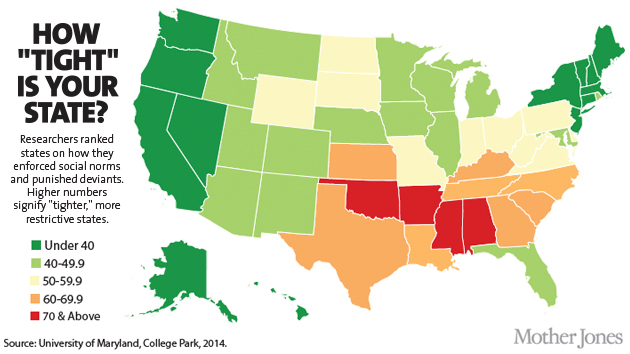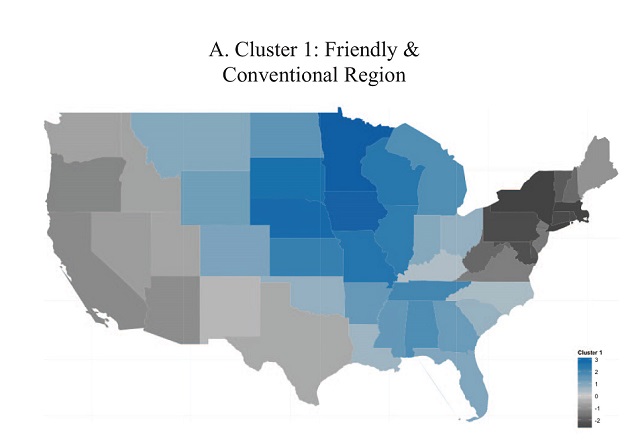
It is obvious to anyone who has traveled around the United States that cultural assumptions, behaviors, and norms vary widely. We all know, for instance, that the South is more politically conservative than the Northeast. And we at least vaguely assume that this is rooted in different outlooks on life.
But why do these different outlooks exist, and correspond so closely to different regions? In a paper recently published in the Proceedings of the National Academy of Sciences (and discussed more here), psychologists Jesse R. Harrington and Michele J. Gelfand of the University of Maryland propose a sweeping theory to explain this phenomenon. Call it the theory of “tightness-looseness”: The researchers show, through analysis of anything from numbers of police per capita to the availability of booze, that some US states are far more “tight”—meaning that they “have many strongly enforced rules and little tolerance for deviance.” Others, meanwhile, are more “loose,” meaning that they “have few strongly enforced rules and greater tolerance for deviance.”
The 10 tightest states? Mississippi, Alabama, Arkansas, Oklahoma, Tennessee, Texas, Louisiana, Kentucky, South Carolina, and North Carolina. The 10 loosest, meanwhile, are California, Oregon, Washington, Nevada, Maine, Massachusetts, Connecticut, Hawaii, New Hampshire, and Vermont. (Notice a pattern here?)
Harrington and Gelfand measure a state’s tightness or looseness based on indicators such as the legality of corporal punishment in schools, the general severity of legal sentences, access to alcohol and availability of civil unions, level of religiosity, and the percent of the population that is foreign. But really, that’s just the beginning of their analysis. After identifying which states are “tighter” and which are more “loose,” the researchers then trace these different outlooks to a range of ecological or historical factors in the states’ pasts (and in many cases, lingering into their presents). For as the authors write, tighter societies generally have had to deal with “a greater number of ecological and historical threats, including fewer natural resources, more natural disasters, a greater incidence of territorial threat, higher population density, and greater pathogen prevalence.”
That applies nicely to the United States. The “tight” states, it turns out, have higher death rates from heat, storms, floods, and lightning. (Not to mention tornadoes.) They also have higher rates of death from influenza and pneumonia, and higher rates of HIV and a number of other diseases. They have higher child and infant mortality. And then there’s external threat: The South, in the Civil War, was defending its own terrain and its own way of life. Indeed, the researchers show a very strong correlation between the percentage of slave-owning families that a state had in the year 1860, and its “tightness” measurement today.
It makes psychological sense, of course, that regions facing more threats would be much more inward-looking and tougher on deviants, because basically, they had to buckle down. They didn’t have the luxury of flowery art, creativity, and substance abuse.
Still not done, Harrington and Gelfand also show that their index of states “tightness” and “looseness” maps nicely on to prior analyses of the differing personalities of people living in different US states. Citizens of “tight” states tend to be more “conscientious,” prizing order and structure in their lives. Citizens of “loose” states tend to be more “open,” wanting to try new things and have new experiences.
Other major distinguishing factors between “tight” and “loose” states:
- Tight states have higher incarceration rates and higher execution rates.
- Tight states have “lower circulation of pornographic magazines.”
- Tight states have “more charges of employment discrimination per capita.”
- Tight states produce fewer patents per capita, and have far fewer “fine artists” (including “painters, illustrators, writers”).
- Most striking of all, the authors found “a negative and linear relationship between tightness and happiness” among citizens. Put more simply: People in loose states are happier.
In sum: It’s a very interesting theory, and one with quite a scope. Or as the authors put it: “tightness-looseness can account for the divergence of substance abuse and discrimination rates between states such as Hawaii and Ohio, reliably predicts the psychological differences…between Colorado and Alabama, helps to explain the contrasts in creativity and social organization between Vermont and North Dakota, and provides some understanding concerning the dissimilarity in insularity and resistance toward immigration between Arizona and New York.”
In these days of extreme political dysfunction, America itself is in increasing need of an explanation. Now, maybe, we have one.















